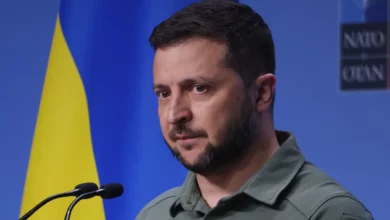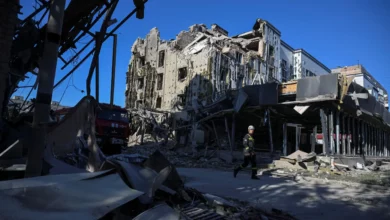
The signing of the second Minsk Agreement in February 2015 was intended to de-escalate the bloody civil war in Ukraine’s eastern Donbass region. However, since the deal was reached, the fighting has continued, with fighters loyal to Kiev locked in a low-level war of attrition with the ethnic Russian population.
Though heavy weapons were withdrawn from the Donetsk and Lugansk provinces, the two sides continue to shoot at each other with smaller weaponry, frequently breaching the ceasefire that is supposed to have been in place for 18 months.
As recently as May this year, journalists seeking to visit the east of Ukraine from Kiev were warned against making the trip, so real was the danger of getting killed or injured. Even so, we were determined to go, to see for ourselves how things had panned out in Europe’s forgotten war.
Heading for no-man’s land
Sitting in a pavement café on Maidan Square – scene of the mass protests of early 2014 – it is clear that spring had arrived in Kiev. Girls walk around in mini-skirts and high-heels, young boys stare intently at their mobile phones. Nearby, the fascist militia of Ajdar – complete with Germanic insignia – is laying flowers at a monument.
Suddenly, my phone rings.
"Good afternoon. This is János Kollár from the embassy," says the voice.
"Good afternoon," I reply.
"I'm calling to inform you that if you travel to Donetsk, we can't guarantee any consular protection for you."
"Understood."
"It's not that simple. I also have to warn you not to go."
"All right," I say.
"Then I will inform the Foreign Affairs Ministry that we have told you not to go. Are you really sure you want to go? We hear terrible rumours from the east – highway robbers and so on."
"We are sure."
"Take care of yourselves."
I put down the phone. We pay for the coffee and leave.
I am travelling with a Hungarian movie director, aiming to head as far east as we can manage. Our first stop will be the city of Kramatorsk, and we intend to depart Kiev at 3 pm, travelling in a battered red van.
We expect dozens of checkpoints, but we are pleasantly surprised. In 2014, practically the entire eastern region was full of military checkpoints – known as "block-posts" in Ukraine. Now, however, we have no trouble driving out of Poltava, the last major city before entering Donetsk province.
A road sign pointing to Donetsk in Ukraine's eastern Donbass region (Photo: Sándor Jászberényi)
Before we go any further, though, we must change our vehicle, putting ourselves under the protection of Sergey Varatin, who will act as driver, fixer and translator from here on. Sergey is a veteran of the battle of Debaltseve, a fierce conflict in January and February 2015 that saw Kiev loyalists forced into retreat.
He is waiting for us, ready to help us through the checkpoint. A young soldier with a bored expression waves us through. There is no security check; we don’t even have to show our passports.
Having passed through this last checkpoint, we are shown to a small and tidy apartment that has been reserved for us. We will spend the night here before continuing the next day.
"Tomorrow,” says Sergey, “we’re going into no-man's-land.”
A pro-Kiev soldier stands guard in Ukraine's simmering civil war (Photo: Sándor Jászberényi)
Once upon a time there was a conflict
The main square of Kramatorsk doesn’t seem to have changed much since the 1950s, when Ukraine was part of the Soviet Union. The main change, it seems, is the removal of the Lenin statue, which was pulled down in 2014 when the conflict in Donetsk began. It is more than a cosmetic difference, reflecting the rapid transformation — some would say deterioration — of the formerly Soviet nation in the past few years.
The simmering conflict in the east was itself the result of a change in government in Kiev in February of 2014, a bloody event some have called a popular uprising, while others call it a foreign-backed coup aimed at securing the nation’s entry into the European Union.
Whatever the real causes, the death toll since then has been staggering, with more than 9,000 people killed in fighting, according to Ukrainian officials.
An ambulance waiting for casualties in the rumbling conflict in eastern Ukraine (Photo: Sándor Jászberényi)
After the dramatic changes in Kiev, the eastern provinces of Donetsk and Lugansk — part of the larger Donbass region — rose up against the new Ukrainian government. With Russian support, they were able to bring a large area under their control. The Ukrainian government's armed forces tried to win the territory back, but without great success.
They were confronted by a well-equipped rebel army, apparently with access to weapons — including heavy artillery pieces — supplied by Russia. It is an open secret that the Russian army intervened in Ukraine on the orders of Vladimir Putin, beginning with the occupation of the Crimea and followed by conflict with Ukrainian troops in the Donetsk region. However, to date, Moscow has not openly admitted direct intervention in Donbass.
In September 2014, representatives of Russia, Ukraine and the two breakaway provinces signed the first Minsk Protocol, aimed at establishing a ceasefire, while taking the first steps toward decentralization of power, allowing ethnic Russian provinces more autonomy. However, by January 2015, the ceasefire had failed, and a new agreement was needed.
With additional help from European nations — particularly Belarus, France and Germany — a second agreement called Minsk II was signed in February 2014, bringing a fragile ceasefire. Among the key points of the agreement was the creation of a buffer zone between the warring parties. It also stipulated the withdrawal of heavy artillery pieces — those over 100mm and multiple rocket-launching systems — to a safe distance, thus reducing the chances of heavy bombardments. Both sides largely complied with these terms, and international observers from the Organization for Security and Co-operation in Europe continue to monitor the situation.
However, despite the reduction in violence, it was clear that neither side was entirely happy with the uneasy peace, nor the political terms agreed. The Kiev loyalists were particularly annoyed at the clauses guaranteeing special rights to the eastern rebels, both in terms of autonomy and freedom from punishment for their insurgent uprising.
Ukraine’s new president, Petro Poroshenko, reportedly signed the second Minsk Agreement only to save the army. According to Ukrainian political analysts, Putin figuratively "held a gun" to Poroshenko’s head, forcing him to accept the outcome.
Many feel the Minsk II agreement can’t be sustained in the long-term, but for now it seems the only way of preventing another military and security meltdown.
‘Give and take’ every night
The various humanitarian organizations working in the conflict zone tell us that the official estimates of casualties are far from accurate. The true death toll is closer to 15,000, some 6,000 higher than admitted by the Ukrainian Interior Ministry.
Relief workers say 1,164 bodies had been found in addition to those already identified by the authorities. Meanwhile, another 1,500 are still missing, presumed dead, laying somewhere in the woods near Debaltsevo, where the fiercest battles were fought in 2014.
During our previous trip, back in 2014, we felt the heavy artillery shaking the ground, and few of the fighters we met then are still alive. Even now, as I write these lines, there are dead soldiers scattered about the nearby forests. Due to the ongoing fighting, the NGOs are not able to find and bury them.
The continued use of small-arms and mortars means that even the buffer zone is not safe, despite the common view outside Urkaine that a peace of sorts has been established.
Before leaving Kiev on our little trip eastwards, we spoke with a Hungarian-born military intelligence agent serving in the Ukrainian army. On condition of anonymity, he explained the current situation on the front lines, insisting that artillery was still being used, despite claims to the contrary.
"They're not shelling?” he said. “Yeah, my ass they aren’t!”
A Ukrainian soldier rests in one of the many fox-holes. There is more than 500 km of trench-line in the Donbass front-line area. (Photo: Sándor Jászberényi)
Back in Donbass, it’s clear to us that there is indeed a rumbling conflict. The two sides are battling over the small town of Avdiivka, 13 km from the city of Donetsk. The ethnic Russian separatists want to occupy the town's factory buildings. The Kiev loyalists, however, are not willing to give up an inch of land.
Even though everyone knows our driver Sergey personally, we become stuck at the blockpost before last.
"What are you going to do if a sniper shoots your Hungarian pals, or they step on a mine?" he is asked by a guard.
It’s quite a good point, and a reason not to continue further. The garrison commander anonymously tells us that regular Russian troops are gathering on the other side of the checkpoint.
Despite our quandary, it’s clear that life continues almost as normal for local residents. We are barely two kilometers from the front line, but the locals are peacefully going about their business, including a mother pushing a pram with a new-born baby in it. They can hear the weapons barking loudly from afar, but they seem unimpressed.
We stop an old man as he’s travelling home in his polyester jogging suit, asking how it feels to be so close to the sound of gunfire.
"This is nothing,” he tells us. “They fire the grenades at night," he says, referring to the use of grenade launchers, which can lob explosives hundreds of meters.
The heavily damaged front of a tenement building in Avdiivka. In spite of heavy mortar shelling people are still living in the building. (Photo: Sándor Jászberényi)
Almost every night, one or more combatants are killed, but it’s the civilians who suffer most.
Near the last blockpost, for example, there is a tower block that is completely riddled with bullets down its front, but families still live in the back side of the building. They simply can't afford to move away.
Meanwhile, cities recaptured from the separatists, such as Slavyansk and Kramators, can't absorb any more refugees. They also have no money.
The OSCE continuously calls attention to violations of the ceasefire agreement on both sides. They have reported the presence of heavy weapons in the separatist regions, capturing the images on drones — those that are not shot down.
Little hope for the future
No one knows for sure how things will work out. Even in the Ukrainian parliament, the most they can do is guess.
Far-right political parties in Ukraine — such as the Praviy Sector and the Svoboda party — aim to continue the conflict with the eastern rebels until all the territory has been brought under the control of the new government in Kiev, even if that means abandoning Minsk II.
However, Russia made clear in 2014 that it would respond to any Ukrainian military operation by sending in its army, which is bigger and better than Ukraine’s. The People’s Republics of Donetsk and Luhansk would prefer to join Russia immediately, but is seems Russia, groaning under economic sanctions imposed by the West, is not keen to go down that road.
An agricultural vehicle from the Soviet era at the entrance of Slaviansk (Photo: Sándor Jászberényi)
Economic considerations are also weighing heavy on Ukraine, with unemployment and poverty widespread in the country. While signs of stagnation and hardship are clear in the Ukrainian-speaking areas to the west, things are much worse in Donbass, scene of most of the fighting.
According to the Hungarian-born military intelligence agent, Donbass will likely go the same way as Abkhazia, a break-away region of Georgia that has receive Russian military and economic support since the early nineties.
"It'll be just like Abkhazia," he says. "It will become a wilderness of weed."




